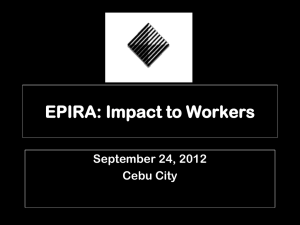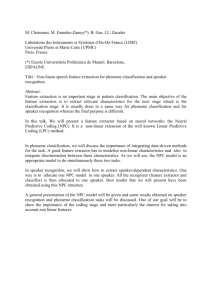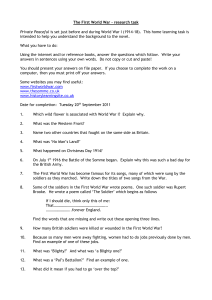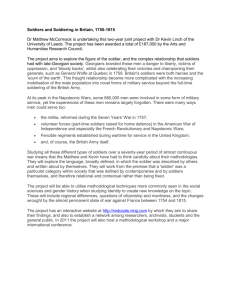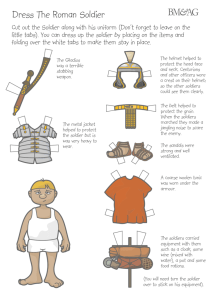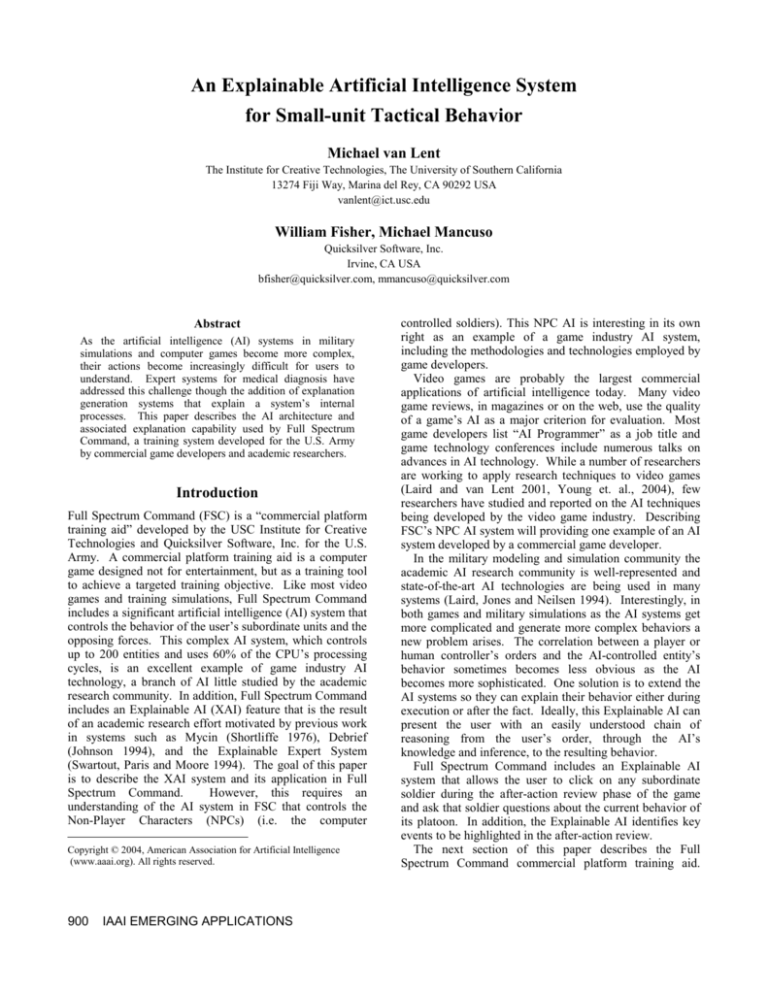
An Explainable Artificial Intelligence System
for Small-unit Tactical Behavior
Michael van Lent
The Institute for Creative Technologies, The University of Southern California
13274 Fiji Way, Marina del Rey, CA 90292 USA
vanlent@ict.usc.edu
William Fisher, Michael Mancuso
Quicksilver Software, Inc.
Irvine, CA USA
bfisher@quicksilver.com, mmancuso@quicksilver.com
Abstract
As the artificial intelligence (AI) systems in military
simulations and computer games become more complex,
their actions become increasingly difficult for users to
understand. Expert systems for medical diagnosis have
addressed this challenge though the addition of explanation
generation systems that explain a system’s internal
processes. This paper describes the AI architecture and
associated explanation capability used by Full Spectrum
Command, a training system developed for the U.S. Army
by commercial game developers and academic researchers.1
Introduction
Full Spectrum Command (FSC) is a “commercial platform
training aid” developed by the USC Institute for Creative
Technologies and Quicksilver Software, Inc. for the U.S.
Army. A commercial platform training aid is a computer
game designed not for entertainment, but as a training tool
to achieve a targeted training objective. Like most video
games and training simulations, Full Spectrum Command
includes a significant artificial intelligence (AI) system that
controls the behavior of the user’s subordinate units and the
opposing forces. This complex AI system, which controls
up to 200 entities and uses 60% of the CPU’s processing
cycles, is an excellent example of game industry AI
technology, a branch of AI little studied by the academic
research community. In addition, Full Spectrum Command
includes an Explainable AI (XAI) feature that is the result
of an academic research effort motivated by previous work
in systems such as Mycin (Shortliffe 1976), Debrief
(Johnson 1994), and the Explainable Expert System
(Swartout, Paris and Moore 1994). The goal of this paper
is to describe the XAI system and its application in Full
Spectrum Command.
However, this requires an
understanding of the AI system in FSC that controls the
Non-Player Characters (NPCs) (i.e. the computer
Copyright © 2004, American Association for Artificial Intelligence
(www.aaai.org). All rights reserved.
900
IAAI EMERGING APPLICATIONS
controlled soldiers). This NPC AI is interesting in its own
right as an example of a game industry AI system,
including the methodologies and technologies employed by
game developers.
Video games are probably the largest commercial
applications of artificial intelligence today. Many video
game reviews, in magazines or on the web, use the quality
of a game’s AI as a major criterion for evaluation. Most
game developers list “AI Programmer” as a job title and
game technology conferences include numerous talks on
advances in AI technology. While a number of researchers
are working to apply research techniques to video games
(Laird and van Lent 2001, Young et. al., 2004), few
researchers have studied and reported on the AI techniques
being developed by the video game industry. Describing
FSC’s NPC AI system will providing one example of an AI
system developed by a commercial game developer.
In the military modeling and simulation community the
academic AI research community is well-represented and
state-of-the-art AI technologies are being used in many
systems (Laird, Jones and Neilsen 1994). Interestingly, in
both games and military simulations as the AI systems get
more complicated and generate more complex behaviors a
new problem arises. The correlation between a player or
human controller’s orders and the AI-controlled entity’s
behavior sometimes becomes less obvious as the AI
becomes more sophisticated. One solution is to extend the
AI systems so they can explain their behavior either during
execution or after the fact. Ideally, this Explainable AI can
present the user with an easily understood chain of
reasoning from the user’s order, through the AI’s
knowledge and inference, to the resulting behavior.
Full Spectrum Command includes an Explainable AI
system that allows the user to click on any subordinate
soldier during the after-action review phase of the game
and ask that soldier questions about the current behavior of
its platoon. In addition, the Explainable AI identifies key
events to be highlighted in the after-action review.
The next section of this paper describes the Full
Spectrum Command commercial platform training aid.
Figure 1: The execution matrix development screen from the planning phase. The
column on the right is one phase of an execution matrix populated with a task for each
of four platoons. A fifth platoon has no task assigned.
The following section gives a detailed overview of the
game’s AI system. The next section describes the
Explainable AI system in more detail and fits it into the
context of previous work on explanation systems. The fifth
section details the deployment of Full Spectrum Command
and provides some feedback and evaluation results.
Finally, the last section describes a number of directions for
future research that could improve the effectiveness of the
Explainable AI system.
Full Spectrum Command
Unlike traditional video games, which are designed for
entertainment and profitability, Full Spectrum Command is
designed to train and exercise the cognitive skills involved
in commanding a light infantry company. However, this
doesn’t mean that FSC isn’t entertaining. Entertainment is
used as a powerful tool to increase the application’s
effectiveness as a training system. Because FSC is
engaging, soldiers spend more time using the training aid
and even choose to train in their free time.
Full Spectrum Command is a Windows XP application
that requires a 2GHz Pentium 4 processor, 512 MB of
system RAM, and a GeForce4 graphics accelerator with
128 MB of video RAM. In the training aid the user is
placed in the role of a U.S. Light Infantry Company
Commander with the rank of Captain. The user controls
about 120 soldiers who are divided into 3-5 platoons and
associated elements. The FSC missions focus on urban
combat against an asymmetric opponent (i.e. terrorists and
insurgents who don’t wear uniforms or fight as an
organized military unit). The game’s virtual environment
recreates the physical urban combat training site located at
Ft. Benning, GA. Called the McKenna MOUT (Military
Operations, Urban Terrain) site, this is where light infantry
company commanders conduct live training exercise in
urban combat. Our virtual McKenna can be populated with
up to 80 civilians and opposing soldiers and configured for
daytime or nighttime missions.
Full Spectrum Command’s game-play is most similar to
the Real Time Strategy (RTS) game genre which includes
games such as Warcraft and Age of Empires. In RTS
games the player acts as a commander controlling the
gathering of resources, production of units, and issuing
orders to these units in battles against one or more
opponent commanders. In most RTS games the player
views the world from a top-down or “God’s eye” view.
Full Spectrum Command differs from traditional RTS
games in a number of key ways. First, FSC doesn’t include
the resource gathering and unit production aspects of most
RTS games. In the game, as in real life, company
commanders begin each mission with an assigned company
of soldiers that may or may not be at full strength. A
“mission” in FSC proceeds in three phases: planning,
execution, and after-action review. In the planning phase
the user reads the operation order (the goal and details of
the assigned mission), organizes the composition of his
forces, and creates an initial plan for the entire mission.
IAAI EMERGING APPLICATIONS 901
Figure 2: The mission playback screen from a Full Spectrum Command after-action
review session.
This plan is represented as an “execution matrix” which
includes a row for each sub-unit of the company (each
platoon) and a column for each time-based phase of the
mission plan (see Figure 1). “Go codes” (key words called
over the radio) or pre-defined time stamps are set up to
coordinate the actions of the platoons and transition
between phases of execution. Once the plan is complete
the user moves on to the execution phase by clicking the
“Execute” button.
In the execution phase the user monitors the behavior of
his soldiers as they carry out the execution matrix, gathers
information about the location, composition and actions of
the opposing soldiers, and modifies the initial plan by
issuing “on the fly” orders called fragmentary orders or
Fragos. Unlike the God’s eye view of traditional RTS
games, the user in FSC must monitor the battle and adjust
his plan from the first-person perspective of the company
commander’s avatar in the game world, which is sometimes
fairly far away from the action. This includes the
possibility that the user’s avatar will be killed which results
in immediate mission failure. During the execution phase
the user moves around the environment, sends and receives
radio transmissions from both subordinate and superior
units, monitors the actions of his soldiers and the
opposition, and issues Fragos to modify his initial plan. An
important part of the company commander’s job is
maintaining “situational awareness” – a clear mental model
of what is happening in the simulated world. This includes
recognizing when the mission objective has been achieved
or when the company is incapable of achieving the mission.
902
IAAI EMERGING APPLICATIONS
The final phase of Full Spectrum Command is the afteraction review (AAR). Both the military (Morrison and
Meliza 1999) and educational researchers (Katz and
Lesgold 1994) have identified the importance of postproblem reflection. During the AAR the user and an
instructor are provided with a new set of user interfaces and
tools designed to help uncover what happened, why it
happened, and how the user could have done better. The
AAR interfaces include a mission statistics screen, an
operation order review screen, a screen that presents the
user’s initial plan for review, a similar screen that presents
the opponent’s plan for review, and a mission playback
screen. From an AI perspective the most interesting
components of the after-action review is the mission
playback screen.
The mission playback screen gives the user and
instructor the ability to replay the mission with controls to
pause, rewind and fast forward the playback (see Figure 2).
Unlike the execution phase, the user views the playback
through a God’s eye camera that can move freely to see
what was happening at any point in the game at any time.
The Explainable AI system enhances this playback
capability in two ways. First, a set of rules extracts key
events from the mission log and represents these as hash
marks on a mission time line. Places on the time line where
these event and decision hash marks are tightly grouped are
often particularly important points in the replay. The user
can scroll along the time line and view some details of each
hash mark including buttons to jump to the time and
location of that event or decision.
The second
enhancement the XAI system provides is the capability to
click on any AI-controlled soldier in the playback window
and access a pop-up menu of questions that can be asked of
that soldier. The content of these questions and the
corresponding answers, as well as the key events and
decision points, will be described in more detail during the
discussion of the XAI system later in this paper.
The AI System
There are two artificial intelligence systems in Full
Spectrum Command. The Non-Player Character (NPC) AI
controls the behavior of the player’s subordinate units, the
opposing force, and any civilians during the execution
phase. The Explainable AI (XAI) works during the afteraction review phase to extract key events and decision
points from the playback log and allow the NPC AI
controlled soldiers to explain their behavior in response to
the questions selected from the XAI menu. In order to
describe the application of the explainable AI research in
Full Spectrum Command it is necessary to first provide an
overview of the NPC AI which the XAI seeks to explain.
A description of the NPC AI is also interesting as an
example of an artificial intelligence system developed not
by academic researchers but by commercial game
developers. While the underlying ideas have similarities to
a number of AI research areas their realization is driven by
the processing, memory, and development effort constraints
of industry developers.
The NPC AI in Full Spectrum Command is divided into
two AI subsystems; a Control AI and a Command AI (see
Figure 3). The Command AI and Control AI software
modules act as cooperative, event-driven message handlers.
The simulation sends a stream of event messages to the
Control AI which determines if each event requires an
immediate reaction (i.e. return fire or take cover). If so, the
Control AI responds with an action notification.
Depending on the event type the Control AI may pass the
event to the Command AI which generates higher-level
tactical behavior. Because the Command AI operates in a
separate processing thread, it can take additional time to
generate more complex behavior based on a database of
task knowledge.
The Control AI is responsible for reactive behavior and
low level actions of individual soldiers and, in some cases,
the smallest unit or grouping of soldiers (a four soldier Fire
Team). It manages all low level decision-making and
reactive behaviors (e.g. path planning, find cover, return
fire) for NPC Objects. The Command AI is responsible for
the behavior of the higher echelon units such as platoons
(about 30 to 50 soldiers in 3-5 squads), squads (typically 9
soldiers in two fire teams plus a squad leader), and the fire
team behavior not covered by the Control AI. The
Command AI manages all strategic level decision making
functions (e.g. task selection, task assignment, and unit
organization). The Control AI is integrated into the
application’s basic simulation loop along with standard
game components such as rendering, user input and physics
simulation. To maintain an acceptable frame rate the
Figure 3: The structure of the AI systems in Full
Spectrum Command.
simulation needs to cycle through this loop at least 30 times
a second placing strict time constraints on each component
of the loop. Thus the Control AI must generate NPC
behaviors, not only quickly, but in a consistently
predictable number of milliseconds. The Command AI
runs in a separate processing thread from the simulation
loop and therefore can take more time to generate higher
level unit behavior without impacting the simulation loop
and frame rate. Both the Control AI and the Command AI
interact with a series of manager services to sense and act
on the state of the simulation. These services include an
NPC manager, a task manager, a map manager a node
manager, and a path manager.
In each cycle through the simulation loop the Control AI
is called to execute the atomic actions of the Control AI’s
current set of tasks. These atomic actions include moving a
soldier or fire team to a new location, changing a soldier’s
stance (standing, kneeling, prone) or firing a soldier’s
weapon. The majority of the Control AI’s time is spent on
path planning for moving soldiers to new locations. Full
Spectrum Command’s map includes an embedded
navigation graph stored in the map manager. NPCs moving
through the environment are actually moving from node to
node along the edges of this graph. The graph is carefully
constructed so that an NPC that moves along the edges of
the graph will never collide with a barrier in the game
world. Thus, the path planning code doesn’t need to know
anything about the locations of buildings, trees and other
barriers in the game world. All this spatial information is
implicitly represented in the navigation graph. The
navigation graph was developed by an automated graph
generation algorithm with a great deal of fine tuning by the
developers. This is a common approach to path planning in
the game industry that has the advantage of very efficient
path planning through an A* search over the navigation
graph. The navigation graph does require some additional
IAAI EMERGING APPLICATIONS 903
storage, beyond the polygonal map representation used by
the graphics renderer, and fine tuning the graph is a time
consuming process. First person shooter games, such as
Quake and Unreal Tournament, usually include fully
automated navigation graph generation which allows users
to easily develop and modify maps without having to
embed their own navigation graphs. The transfer of such
computationally intense tasks from run time to compile
time is key to the success of this implementation strategy.
The Control AI changes the stance of an NPC soldier by
simply updating the state of that NPC in the NPC manager
which in turn changes how the character is rendered by the
graphics engine. Weapon firing is decided when a line of
sight calculation determines that an NPC has spotted an
opposing soldier. The Command AI sends a message to
the Control AI calling for a fire action and specifying a
shooter NPC and a target NPC. The fire-at-enemy action
notification is then sent by the Control AI to the simulation.
The outcome of the weapons fire is determined by a
statistical “combat calculator” that takes into account
factors such as range, shooter and target stance, weapon
type, and the target’s body armor.
The Command AI, running in a separate thread, takes as
input the platoon-level tasks assigned by the user, the task
knowledge stored in the task manager, and a constantly
updated list of events passed from the simulation thread
through the Control AI to the Command AI. Full Spectrum
Command tasks are organized into a task hierarchy
containing N total tasks in M levels. At the top of the task
hierarchy are N platoon-level tasks, such as clear-building,
move-to-checkpoint, and execute-supporting-fire, and M
high-level tasks used only by the opposing force (or
OPFOR), such as shoot-and-scoot and ambush. As
described previously, during the planning phase of FSC the
user creates an execution matrix that assigns one of these
platoon-level tasks to each platoon for each phase of the
mission. Similarly, for each mission the mission designer
creates an execution matrix assigning tasks for each
OPFOR unit. The Command AI takes each top-level task
and decomposes it into sub-tasks, sub-sub-tasks and so on.
Each time a task is decomposed the Control AI breaks the
associated unit into sub-units and assigns a sub-task to each
unit.
For example, when a platoon begins a clear-building task
the Command AI will decompose that task into two subtasks; secure-building-perimeter and assault-building. The
platoon will be broken into two parts, in this case a single
security squad and a multiple squad assault unit. The
security squad will be assigned the secure-buildingperimeter tasks while the assault unit will be assigned the
assault-building tasks. The assault-building task will then
be further decomposed into one or more clear-floor tasks,
one for each floor of the building. The assault unit will be
divided into floor clearing units (typically squads), who are
then assigned to clear the floors in a specific order, one at a
time. The clear-floor task for the initial floor will be
divided again into multiple clear-room tasks, assigned to
fire teams, with each clear-room task resulting in a set of
904
IAAI EMERGING APPLICATIONS
movement orders for the individual soldiers to achieve
“positions of dominance” within that room. Once the first
room is cleared that fire team becomes available and can be
assigned to another clear-room task on the same floor. In
decomposing the tasks and forces the Command AI
generally follows U.S. Army doctrine although some
deviations do occur due to difficulties in getting subject
matter experts to agree on an interpretation of the doctrine
and constraints on the development timeline. While these
differences aren’t apparent when observing the resulting
behavior they will have ramifications for the explainable
AI.
Events in Full Spectrum Command consist of a set of
pre-conditions, a set of goal conditions, and a set of task
abandonment conditions. In addition, each task includes a
list of child tasks in the task hierarchy and is associated
with a C++ function that is called to execute the task. A
task is executed when it is invoked by a parent task (or
directly from the user’s initial plan) and its pre-conditions
are satisfied by the events passed to the Command AI.
When a task is executed its C++ function is called which
performs the unit and task decomposition and/or sends an
action notification to the Control AI.
If a task’s
abandonment conditions are met the Command AI stops
executing the task and a report is sent to the user. For
example, if too many soldiers are wounded or killed a unit
may become “combat ineffective” in which case the
remaining soldiers will seek cover and a radio report to the
user will report that the unit has taken heavy casualties.
Explainable AI in Games and Simulations
As the previous description makes clear, the behavior of
the individual NPCs in Full Spectrum Command starts with
the user’s platoon-level orders but is the result of a number
of unit and task decomposition mixed with the reactive
behavior of the Control AI. Other video games and
military simulation systems include similarly complex
processes to generate entity level behavior from orders to
larger groups or units. As these AI systems have become
more complex their inner workings have become less
obvious to users. In training simulations, this can result in
users who feel their orders don’t really affect the NPC’s
behavior or users who may try to place blame for failure on
the AI systems rather than their own orders.
Related Work
Interestingly, the problem of explaining the internal
processing of an AI system has been previously considered
by the research community only in a different context.
Medical diagnosis expert systems, such as Mycin
(Shortliffe, 1976) used a complex set of rules to diagnose
illness and suggest treatments based on patient statistics
and test results. Early on the developers of these systems
realized that doctors weren’t willing to accept the expert
system’s diagnosis on faith. As a result these systems were
designed not only to diagnose an illness but also provide
explanations of how the diagnosis was generated.
Explanation systems have also been applied to educational
applications such as teaching LISP programmers to
improve their code (Swartout, Paris and Moore 1994) and
to assist knowledge engineer with debugging description
logics (McGuinness and Borgida 1995).
One previous effort in the military simulation field is
the Debrief system (Johnson, 1994). Debrief allows Soar
agents to justify their actions in the TacAirSoar tactical air
combat domain (Laird, Jones and Nielsen 1994). Debrief
uses Soar’s built in learning mechanism to continually store
the agent’s state during a mission. During the after action
review (or debriefing) the system can recall the state of the
agent at various points during the mission and experiment
with different modifications to that state to determine
which aspects of the state were critical to the agent’s next
decision. By performing this analysis Debrief can report
the critical attribute values that resulted in the agent’s
decision. Debrief can also justify an agent’s internal
beliefs through a similar process of recalling an agent’s
state and examining how the agent’s beliefs change in
response to changes to state attribute values. Debrief
explanations are presented through structured natural
language phrases and graphical displays of aircraft
positions. Debrief makes use of a number of Soar-specific
mechanisms, such as chunking, and thus isn’t directly
applicable to systems not based on Soar. However, the
underlying idea of logging an agent’s behavior and
examining that log during the after-action review to extract
critical state features and explanations was influential in the
development of the XAI system for Full Spectrum
Command.
Explainable AI in Full Spectrum Command
The Explainable AI system in Full Spectrum Command
logs the activities of the NPC AI system during the
execution phase and uses that log during the after-action
review phase. The log consists of a long sequence of AI
events records each with an associated time stamp. The
events that are recorded in the log include:
Weapon Fire: generated when an NPC shoots at another
NPC. Records the weapon type, range, shooter and target
details, chance to hit, hit result (did the shooter hit) and the
effect of the shot on the target.
Unit Generation: generated when the player or NPC AI
creates a new unit (i.e. the player creates a fourth platoon
within the company or the NPC AI decomposes a platoon
into squads). Records the unit id, parent unit’s id,
formation, unit purpose (security, assault, guard…), NPC
count, task assignment, status (idle, waiting, active), leader
id, and whether the unit is in position or on the move.
Unit Update: generated when the details of a unit are
modified by the player or NPC AI. Records the aspects of a
unit that could be changed which are formation, unit
purpose, task assignment, status and in-position. NPC
count doesn’t change since wounded or killed NPC are still
considered part of the unit.
Task Generation: generated when a unit is assigned a new
task (i.e. clear-building is decomposed into securebuilding-perimeter and assault-building). Records task id,
id of the unit to which the task is assigned, task status
(complete, incomplete, inactive) and parent task id.
Task Update: generated when the details of a task are
modified (i.e. records that secure-building-perimeter is
completed). Records the task id and task status which is
the only detail of a task that can change.
A typical mission in FSC will take between 30 minutes and
two hours and will generate a log consisting of thousands
or tens of thousands of AI event records. These records are
continually streamed to the hard drive as part of the afteraction review file generated for each mission.
At the beginning of the after-action review phase the AI
log is read from the hard drive and the XAI system reads
through all the records. During this initial pass the XAI
system gathers mission statistics and a list of important
events to support the after-action review process. The
mission statistics gathered includes mission duration,
casualty statistics and ammo usage statistics. While
gathering these statistics doesn’t involve any AI technique,
the information logged for the XAI is the easiest place to
gather this data.
During this first pass through the logged AI events the
system also gathers a list of important events that should be
highlighted for the user. These events are indicated by
hash marks on a mission time line displayed at the bottom
of the mission playback screen (see Figure 2). The key
event hash marks are color coded according to which side
the event relates (blue for the user’s units, red for enemy
units and white for civilians). The XAI system detects nine
types of key event:
• Friendly Soldier Killed in Action (KIA)
• Friendly Soldier Wounded in Action (WIA)
• Enemy Soldier Killed in Action
• Enemy Soldier Wounded in Action
• Civilian Killed in Action
• Civilian Wounded in Action
• Friendly Unit First Contact with the Enemy
• Platoon Task Started
• Platoon Task Completed
The KIA and WIA events are a subset of the logged
Weapon Fire records in which the effect of the fire is a
killed or wounded NPC. The platoon task started and
completed events are a subset of the logged Task
Generation and Task Completion records in which the unit
associated with the task is a platoon. The XAI system has
the capability to also include squad and fire-team level task
events. However, as a Company Commander the user
should be focusing on the activities of the platoons which
are his immediate subordinate units. Finally, a “First
Contact with the Enemy” event is generated from a
Weapon Fire record that represents the first time an NPC in
the associated unit has fired on the enemy.
The third job of the XAI system is to explain the
behavior of the platoons during the mission playback. As
the user moves through the mission playback the XAI
IAAI EMERGING APPLICATIONS 905
system moves through the logged AI records to maintain
the current state of each unit and task. Similar to Debrief,
the XAI system uses the logged information to recall the
state of the NPC AI at any point during the mission.
Unlike Debrief, the XAI system doesn’t perform “what if”
simulations but does allow the user to inquire about the
status of tasks and units. On the playback screen the user
can click on any friendly NPC to pop up a menu of
questions the user can select to inquire about the current
behavior of that NPC’s platoon. Early versions of the XAI
system included questions and explanations of squad and
fire-team level behaviors. However, these were later
removed in part to focus the user on the behavior of the
platoons and in part because the explanations uncovered
aspects of the NPC behavior that doesn’t match U.S. Army
doctrine. Limiting the user to a menu of pre-defined
questions ensures that the system can answer the posed
question.
The questions and answers are presented in English.
Each question and answer has an associated sentence (or
multi-sentence) template that is filled in with the details of
the specific situation. The questions available to the user
describe the platoon’s current task, the status of that task,
and the parameters that might affect task execution. These
questions and the associated explanations are presented in
English. These questions are:
What is the platoon’s mission? The answer describes the
platoon’s top-level task and how that task is decomposed
into the next level of sub-tasks. An example answer might
be “2nd platoon’s mission is clear building. This mission
consists of two steps: secure building perimeter and assault
building.”
What is the platoon’s mission status? The answer
describes the status of the platoon’s top-level task (active,
complete, waiting) and the status of each sub-task. An
example answer might be “2nd platoon’s clear building task
is active. 1st squad’s secure building perimeter task is
active. 2nd squad’s assault building tasks is waiting.”
How is the platoon task organized? The answer
describes how the platoon is decomposed into the next
level of sub-units and the number of soldiers in each subunit. An example answer might be “2nd platoon is task
organized into 3 squads. 1st squad has 9 soldiers. 2nd
squad has 9 soldiers. 3rd squad has 7 soldiers.”
How many soldiers are in the platoon? The answer
describes the total number of soldiers in the platoon and
how many of these soldiers have been wounded or killed.
An example answer might be “2nd platoon has 25 soldiers.
Of these 2 soldiers are KIA and 1 soldier is WIA.”
What is the platoon’s ammo status? The answer
describes the ammo status of the platoon as green (less than
75% of ammo has been used), red (more than 75% of
ammo has been used), or black (no ammo remaining) for
each weapon type. An example answer might be “2nd
platoon is ammo status black for heavy weapons and ammo
status red for light weapons.”
906
IAAI EMERGING APPLICATIONS
Preliminary Deployment and Evaluation
Full Spectrum Command has been deployed for
evaluation purposes in the Infantry Captain’s Career
Course (ICCC) at the Infantry School at Ft. Benning.
Starting in the summer of 2002 beta versions were used in
classroom exercises to teach concepts such as execution
matrix development and battlefield synchronization. The
final software was delivered in February 2003 and has been
in use since. In addition, Full Spectrum Command was
used in Afghanistan by U.S. soldiers tasked with training
Captains in the newly created Afghan National Army.
In 2003 the Army Research Institute conducted an
evaluation of the pedagogical effectiveness of Full
Spectrum Command. Although the evaluation wasn’t
designed to explicitly test the NPC AI or XAI, some of the
results provide indirect feedback on these systems.
Soldiers who used FSC in the context of the ICCC were
asked to rank the “relative importance of FSC fidelity” in a
number of different areas. The most important area of
fidelity was “tactical blue force” or the NPC AI of the
soldier’s subordinate units. The second most important
area of fidelity was “tactical red force” or the NPC AI of
the opponent units. Overall 88% of the soldiers indicated
that the fidelity of FSC was “excellent” or “adequate.”
Taken together these results suggest that the soldiers were
watching the NPC AI closely and most found it to be
acceptable. Overall 60% of the soldiers felt FSC has high
training value while 18% of the soldiers felt it has little or
no training value. Unfortunately, the XAI was not
explicitly mentioned in the results of the evaluation. As
discussed in the following section, a separate evaluation is
planned that will focus on the effectiveness of the XAI in
answering user’s questions and determining how the system
should be extended to better support FSC’s training
objectives.
Currently Full Spectrum Command is used by
approximately 20% of the instructors who teach the ICCC.
This number is likely to increase as more computers with
the appropriate graphics accelerator cards are obtained and
more instructors are trained to use the training aid. An
expanded and improved version of Full Spectrum
Command, called FSC 1.5, is currently under development.
This second round of development is being funded by the
Singapore Armed Forces in collaboration with the U.S.
Army.
Future Work
The current NPC AI and XAI systems have a number of
limitations that provide fertile ground for future work.
Probably the greatest limitation with the NPC AI is the
difficulty in modifying the map and internal behaviors.
This has become particularly apparent during the
development of FSC 1.5 as we attempt to modify the NPC
AI to follow the doctrine of the Singapore Armed Forces.
A more modular NPC AI system that includes an
automated spatial reasoning system that can automatically
generate a navigation graph would make adding new maps,
tactics and doctrine much easier. To this end we are in the
process of developing a standard software interface
between the simulation system and key components. This
standard interface will modularize these components and
allow different AI systems to be swapped in and out. This
effort will start with the Command AI, the map/navigation
graph manager, and adding a new strategic AI module
described below. Ideally, this will result in a version of
Full Spectrum Command that serves as a research testbed
in which different ideas and approaches can be compared
and evaluated with respect to fidelity, flexibility,
processing demands, and ease of development.
For the XAI, an immediate next step is to evaluate the
current explanation capability to determine if it meets the
needs of the users. This evaluation should include both
testing of the FSC XAI component and an exploration of
common types of explanations that occur in after-action
reviews of live and simulated training exercises. The
fundamental limitation of the XAI is the depth of the
explanations it can provide. The current XAI system is
limited to explaining how the pre-existing task knowledge
was applied. Unfortunately, this task knowledge defines
how each task should be carried out, but doesn’t include
any deeper knowledge about why each task should be
approached in the specified way. For example, the clearbuilding task indicates that the secure-building-perimeter
sub-task should be completed before starting the assaultbuilding sub-task but no information on why this constraint
is necessary. The NPC AI performs these steps by rote
without any knowledge of why it is important to secure the
perimeter. As a result the XAI system can’t answer
questions such as “Why do I need to secure the perimeter
before I assault the building?”
Previous research into explanation systems have
identified this problem and suggested a number of
solutions. The obvious solution, encoding additional
knowledge into each task providing the underlying
motivation, is unwieldy. It requires an additional, and not
insignificant, step each time a task is developed or
modified. A more promising solution is to encode the
domain’s motivating first principles and use an automated
planning approach to develop behaviors in response to
specific task or mission goals. Because the system is
compiling behaviors from first principles, the deeper “why”
questions can be answered by retracing the behavior
generation process. Although this approach is more
complex it has a number of advantages. Behavior
knowledge and explanations are generated by the same
process from the same source and are guaranteed to match.
Once a domain’s first principles are encoded they are likely
to apply to a wide range of goals and behaviors. It is easier
to validate the behaviors once the first principles are
defined. Finally, the automated planner might find a range
of behaviors that can achieve the same task goals
increasing the variability of NPC behavior.
Acknowledgments
This paper was developed with funds of the Department of
the Army under contract number DAAD 19-99-D-0046.
Any
opinions,
findings
and
conclusions
or
recommendations expressed in this paper are those of the
authors and do not necessarily reflect the views of the
Department of the Army.
References
Johnson, W. L., 1994. Agents that learn to explain
themselves. In Proceedings of the Twelfth National
Conference on Artificial Intelligence, pgs. 1257—1263.
Katz, S. and Lesgold, A. 1994. Implementing post-problem
reflection within coached practice environments.
In
Proceedings of the East-West International Conference on
Computer Technologies in Education. Crimea, Ukraine.
Pgs. 125-130.
Laird, J. E., Jones, R. and Nielsen, P. E. 1994. Coordinated
behavior of computer generated forces in TacAir-Soar. In
Proceedings of the Fourth Conference on Computer
Generated Forces and Behavioral Representation.
Orlando, FL.
Laird, J. E. 2000 It Knows What You’re Going to Do:
Adding Anticipation to a Quakebot. AAAI 2000 Spring
Symposium Series: Artificial Intelligence and Interactive
Entertainment, AAAI Technical Report SS00 -02.
Laird, J. E. and van Lent, M. 2001. Human-Level AI’s
Killer Application: Interactive Computer Games. AI
Magazine, Volume 22 (2), pgs. 15-25.
McGuinness, D. L. and Borgida, A. 1995. Explaining
Subsumption in Description Logics. In Proceedings of the
14th International Joint Conference on Artificial
Intelligence, Montreal, Canada, August 1995.
Morrison, J. E. and Meliza, L. L. 1999. Foundations of the
After Action Review Process. U.S. Army Research Institute
for the Behavioral and Social Sciences Special Report #42.
Shortliffe, E. H. 1976. Computer-based
Consultations: MYCIN. Elsevier, New York.
Medical
Swartout, W. R., Paris, C. L., and Moore, J. D. 1994.
Design For Explainable Expert Systems. IEEE Expert,
Volume 6, Number 3, pages 58-64.
Young, R. M., Riedl, M., Branly, M., Jhala, A., Martin, R.
J. and Saretto, C. J. 2004. An architecture for integrating
plan-based behavior generation with interactive game
environments, The Journal of Game Development, Volume
1 (1).
IAAI EMERGING APPLICATIONS 907



